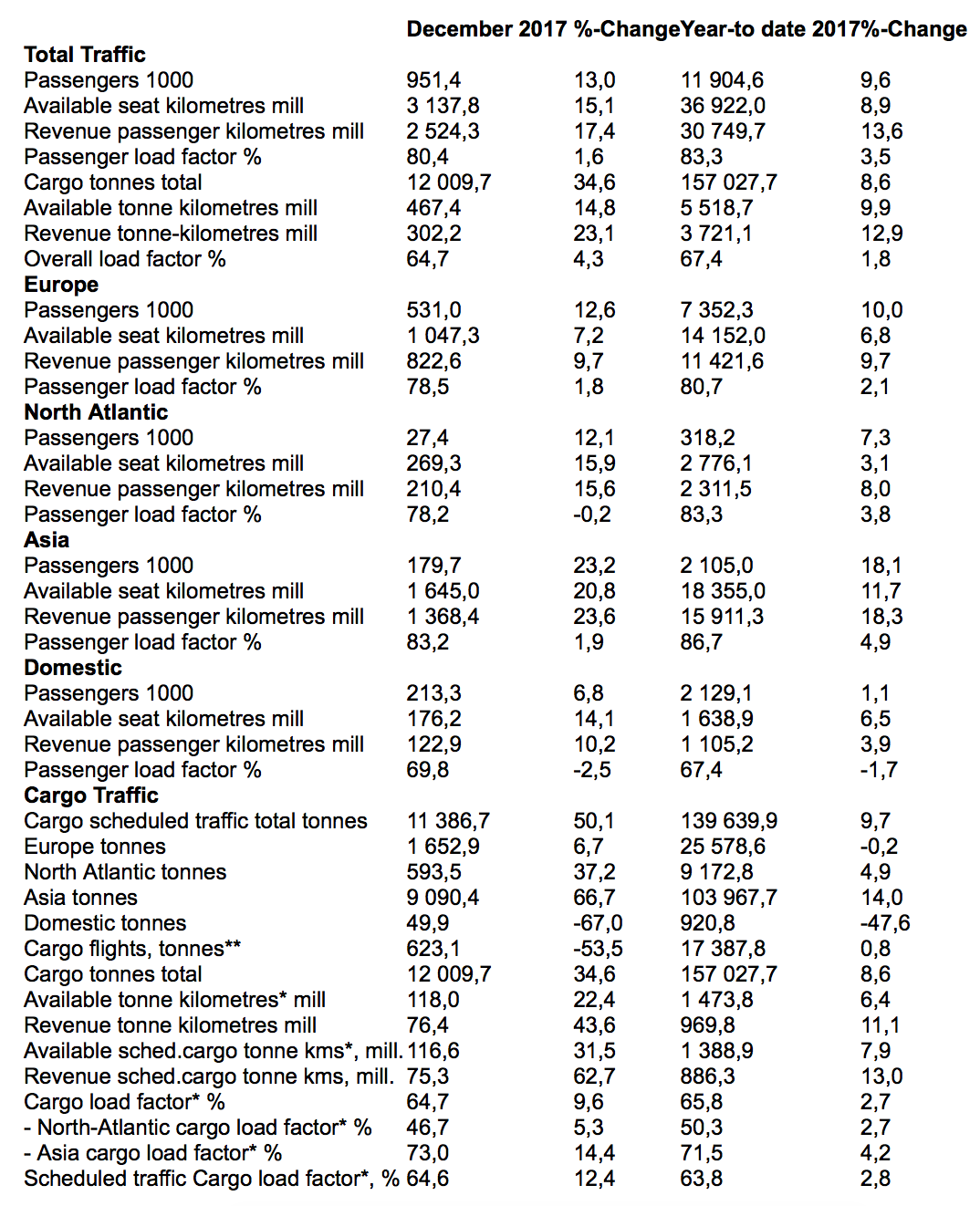Finnair’s December passenger volume reached a new high, the number of passengers per year increased by more than one million to close to 12 million passengers
In December, Finnair's overall capacity measured in Available Seat Kilometres increased by 15.1 per cent year‐on‐year, and traffic measured in Revenue Passenger Kilometres grew by 17.4 per cent. The number of passengers carried in December increased by 13.0 per cent year-on-year to 951,400 passengers, breaking Finnair’s December record. The passenger load factor increased by 1.6 percentage points to 80.4 per cent.
The capacity in Finnair’s largest traffic area, Asia, increased by 20.8 per cent in December. Finnair’s route network in Asia was otherwise the same as in the comparison period, but flights were operated also to the new seasonal destination Goa. Also number of frequencies to Bangkok, Singapore, Hong Kong, Delhi and Tokyo increased year-on-year. Traffic measured in RPK grew by 23.6 per cent, and the passenger load factor increased by 1.9 percentage points to 83.2 per cent.
In North Atlantic traffic capacity increased by 15.9 per cent. Flights to new leisure destination Havana started and operations to New York, Miami and the new seasonal destination Puerto Vallarta, launched in November, continued. Traffic increased by 15.6 per cent and the passenger load factor decreased by 0.2 percentage points to 78.2 per cent.
Finnair’s capacity in European traffic increased by 7.2 per cent reflecting added capacity especially to Stockholm, Copenhagen, Berlin and Moscow. Traffic measured in RPK grew by 9.7 per cent year-on-year. The passenger load factor increased by 1.8 percentage points to 78.5 per cent. Domestic capacity increased by 14.1 per cent and traffic by 10.2 per cent. The passenger load factor decreased by 2.5 percentage points to 69.8 per cent.
Available Scheduled Cargo Tonne Kilometres increased by 22.4 per cent and Revenue Scheduled Cargo Tonne Kilometres increased by 43.6 per cent. The positive year-on-year growth contribution was seen practically in all regions. Especially the development in Greater China was strong in December. Finnair’s total cargo capacity also included three weekly freighter flights between Helsinki and Brussels, operated by DHL. Finnair Cargo’s agreement to rent the cargo space of Japan Airlines’ daily flights between Tokyo and Helsinki ended at the end of October, which was reflected in cargo flights volumes. Finnair’s new cargo terminal COOL was taken gradually in use in the last quarter of 2017 with full cargo operations starting in January 2018.
In December, 64 per cent of all Finnair flights arrived on schedule (72.7).
”The traffic measured in RPK and capacity both continued to grow in December. Exceptionally difficult winter and wind conditions and their multiplier effects, and the overtime working ban by Finnish aviation union, hampered the traffic especially in Finland and Europe. Difficult conditions were reflected especially in flight punctuality and regularity,” says Finnair CFO Pekka Vähähyyppä.
“In terms of traffic performance, the fourth quarter was nonetheless good. Our Q4 capacity increased by 17.2 per cent and traffic measured in RPK grew by 20.2 per cent year-on-year. We carried nearly three million passengers in the last quarter of the year and close to 12 million in 2017,” Vähähyyppä continued.
According to preliminary data, Finnair’s unit revenue, or RASK (total Group revenue divided by ASK), decreased in October–December by 3.4 per cent year-on-year and totalled 6.72 euro cents. Full year unit revenue increased by 1.8 per cent to 6.96 euro cents according to preliminary data.
Traffic statistics for January 2018 will be published on Wednesday, 7 February 2018.
Finnair Traffic Performance December 2017

